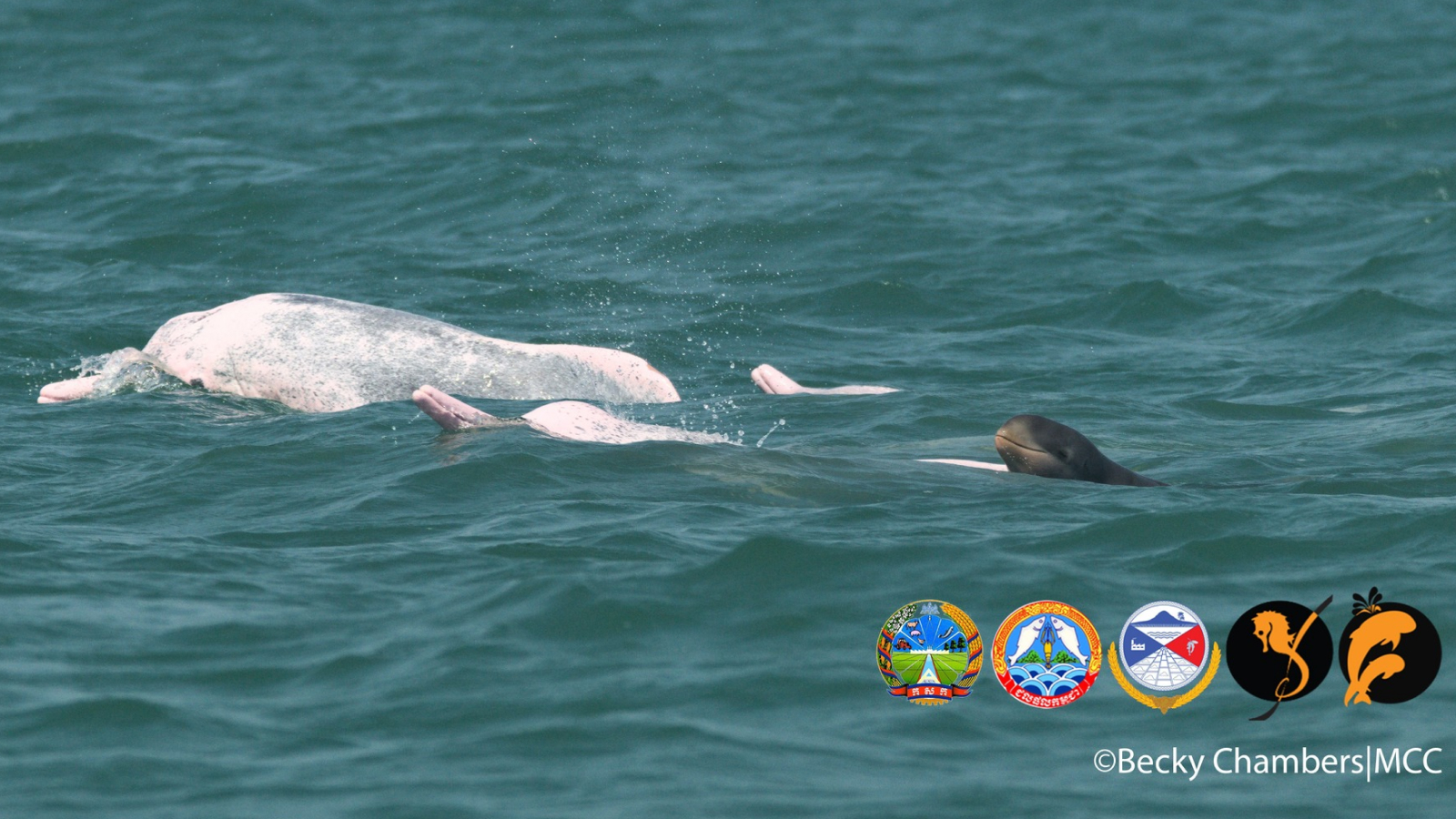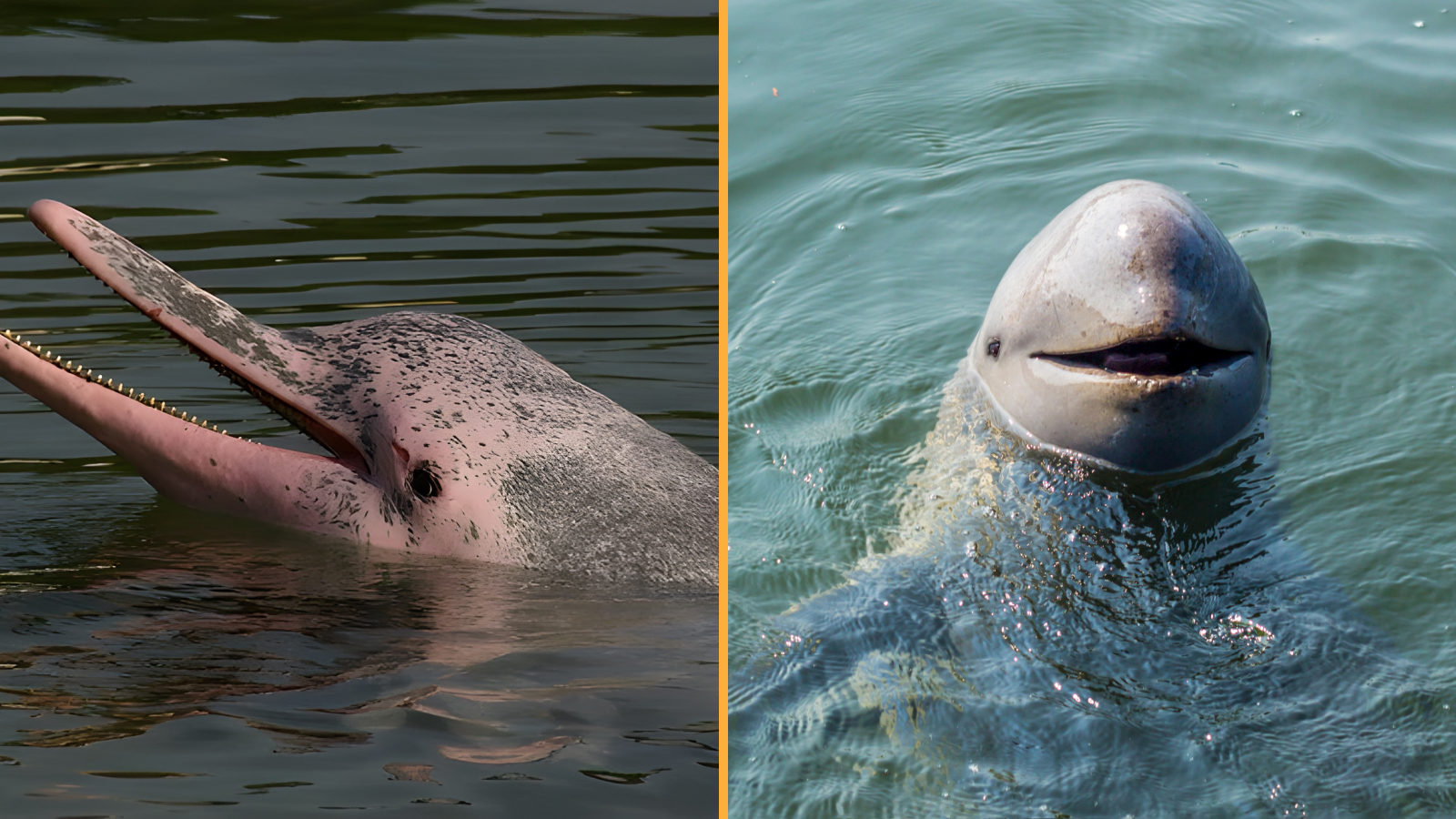Pink dolphins spotted with baby from completely different species in 'mystery' encounter
Researchers snapped a photo of a baby Irrawaddy dolphin in a group of Indo-Pacific humpback dolphins swimming off the coast of Cambodia.

A rare, endangered baby dolphin has been spotted swimming with members of a different species in Cambodia, leaving scientists puzzled.
The Irrawaddy dolphin (Orcaella brevirostris) calf was likely with its mother in a group of Indo-Pacific humpback dolphins (Sousa chinensis). Irrawaddy dolphins are dark gray with squished faces, while Indo-Pacific humpback dolphins are pink with long noses, so the calf and mother stuck out like saw thumbs.
Researchers from Marine Conservation Cambodia (MCC) announced the sighting on May 31, posting on Facebook that the interaction was "extremely unusual" because the two species usually only come together when foraging in the same area.
Becky Chambers, lead scientist at MCC's Cambodian Marine Mammal Conservation Project, told Live Science that her team was really excited to spot the calf, but they weren't sure why the two species were together.
"It is a bit of a mystery," Chambers said. "These are both highly threatened populations of dolphins and the fact that they're having interactions is, at the moment, I would say neither good nor bad."
Related: Dolphins are 'literally acting like jerks' by beating up baby manatees
Irrawaddy dolphins, known for spitting water out of their mouths and helping humans catch fish, are threatened with extinction partly because they get entangled in fishing gear. Researchers don't know how many Irrawaddy dolphins are left in the wild, but their population is severely fragmented, according to the IUCN Red List.
Sign up for the Live Science daily newsletter now
Get the world’s most fascinating discoveries delivered straight to your inbox.

Chambers and her colleagues were conducting dolphin surveys off southern Cambodia on March 12 when they first encountered the young Irrawaddy dolphin calf. "We see juveniles quite often, but this was a newborn, which is an event in itself," she said.
Irrawaddy dolphins have been known to hybridize with Indo-Pacific humpback dolphins, but it's extremely rare, and this calf had all of the physical features of an Irrawaddy dolphin calf, according to the Facebook post. That means that it was likely born from two Irrawaddy dolphin parents.
Both species can engage in alloparenting — providing care to young that aren't direct offspring — which may, in rare instances, extend to other species. However, it's unclear whether the Indo-Pacific humpback dolphins were trying to help care for or harm the calf.
Chambers noted that the Indo-Pacific dolphins may have attempted to separate mother from calf in an act of aggression, perhaps motivated by competition. "I'm on the fence about whether this was an aggressive interaction or not," she said.
But it appears as though the calf survived its time with the Indo-Pacific humpback dolphins. On April 23, one of Chambers' colleagues likely spotted the calf again. This time, the researcher followed a lone Indo-Pacific humpback dolphin, which to their surprise, swam to a group of Irrawaddy dolphins. Why the Indo-Pacific humpback dolphin joined a group of Irrawaddy dolphins is also unclear, but that group of Irrawaddy dolphins had a young calf, and Chambers believes it was the same one that was spotted in the Indo-Pacific humpback dolphin group.
"They didn't have a good camera, so no photo ID could be taken on that occasion, but it would be likely that is the same individual, which is good if it is because it means the calf is still alive," Chambers said.

Patrick Pester is the trending news writer at Live Science. His work has appeared on other science websites, such as BBC Science Focus and Scientific American. Patrick retrained as a journalist after spending his early career working in zoos and wildlife conservation. He was awarded the Master's Excellence Scholarship to study at Cardiff University where he completed a master's degree in international journalism. He also has a second master's degree in biodiversity, evolution and conservation in action from Middlesex University London. When he isn't writing news, Patrick investigates the sale of human remains.









